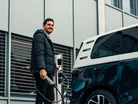ChargePoint pledges actions to expand public EV charging

Since the new year began, there has been a lot of hype around the expansion of the electric vehicle (EV) sector, particularly the fact that the number of all-electric vehicle sales increased drastically during 2022.
The Society of Motor Manufacturers and Traders (SMMT) met last year to discuss some of the key points surrounding the industry, and one of these was the shift to electrified vehicles. The SMMT recently released a report detailing the sales landscape for EVs and the impact it is having on the delivery of internal combustion vehicles (ICVs).
The Chief Executive of the SMMT, Mike Hawes told the BBC that the effects of COVID-19 remain and supply chain disruption is still a major factor in electrification success. While organisations have seen more opportunities arise, and innovation is high, the effects of the global pandemic leave the industry trailing behind its potential.
The UK Government states that 300,000 public charging points are required by 2030 to meet the country’s EV charging demand, which requires a major upshift in infrastructure expansion.
“To get to that 300,000, you need about 100 new charging points to be installed every day until 2030,” Hawes told the BBC.
“Current rates, up until the end of quarter three, were about 23 a day. So the danger is the user experience gets worse before it gets better.”
It’s also important to note the dangers of inadequate charging. While EV sales rise, the charging infrastructure is lagging behind, causing disruption at public charging stations and, in some cases, angering EV drivers.
Which EV sold the most?
The SMMT report shows the UK’s best selling cars of 2022, with Tesla overtaken by two others, remaining in the top three for the automotive industry overall.
10. Ford Fiesta - 25,070
9. Ford Kuga - 26,549
8. Volkswagen Golf - 26,558
7. Hyundai Tucson - 27,839
6. Kia Sportage - 29,655
5. Mini - 32,387
4. Ford Puma - 35,088
3. Tesla Model Y - 35,551
2. Vauxhall Corsa - 35,910
1. Nissan Qashqai - 42,704
An electrified era for automotive hinges on the ‘charging experience’
So what will be the focus for organisations this year? Carmakers, the likes of Volkswagen, Hyundai, and Tesla, are taking care of competition in the automotive industry, but the charging dilemma could present barriers later on. Investment is required to bring chargers up to speed—quite literally—and eliminate range anxiety from the equation.
Commenting on the charging and infrastructure discussion is Tanya Sinclair, Senior Director, Public Policy - Europe, at ChargePoint:
“With an increased investment in the sale of EVs comes the need for an increased policy focus on the supporting infrastructure to ensure the uptake of EVs is set up for success,” Sinclair says.
“It’s not about needing a large concentration of government-funded charging stations—we need to also consider the implementation of effortless and easy charging experiences, scalable designs, quality products, and seamless services.”
This certainly resonates with one of the key topics in the latest issue of EV Magazine, “Life with EVs hinges on charging infrastructure”. In this issue, Sinclair expands on the current EV charging access and how ChargePoint is working to establish better services at facilities and workplaces where EV drivers can charge effortlessly while undergoing other activities.
As the number of electric cars rises, companies must get smart about their public charging offerings as their duty to customers, but also for their impacts as catalysts for change.
“The biggest single, revenue-neutral measure the government can implement today is the Zero Emission Vehicle Mandate—a year-on-year increasing EV sales target for vehicle manufacturers. Today’s figures show that EV sales are already on the rise—a ZEV mandate will ensure there is vehicle supply to support this trend, while also clarifying the future demand for chargers, for companies who are deploying the infrastructure.”
- Voltpost Secures Grants for Nationwide Lamppost EV ChargersCharging & Infrastructure
- San Francisco Expands Curbside EV Charging ProgrammeCharging & Infrastructure
- How Amazon hit one Billion Electric Deliveries in the USFleet & Commercial
- Antimony Crisis: Challenges & Opportunities for EVsTechnology

